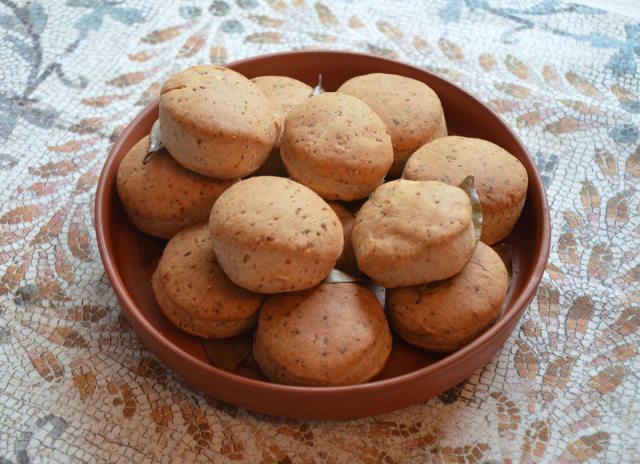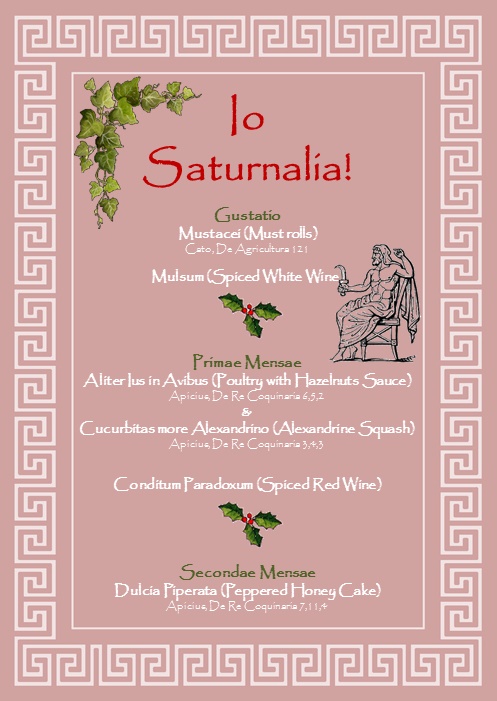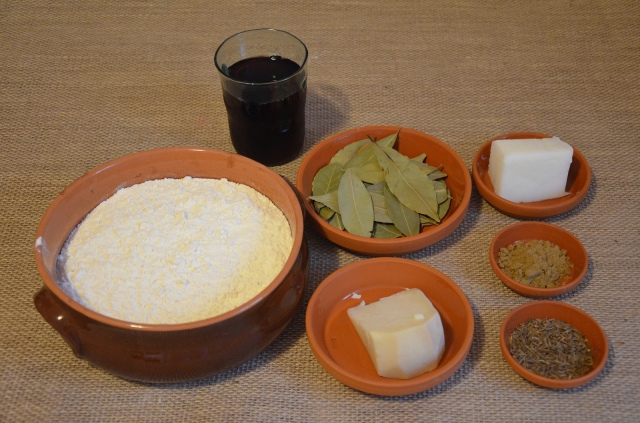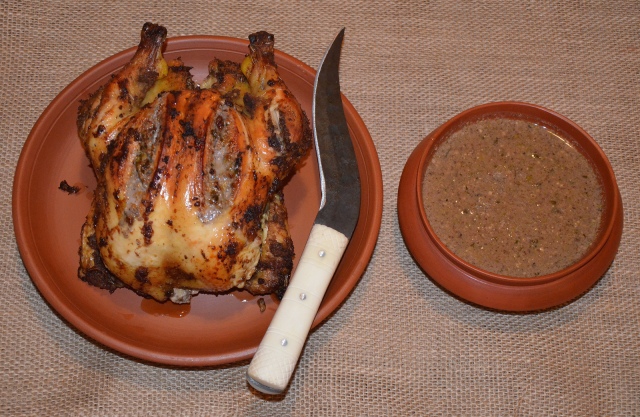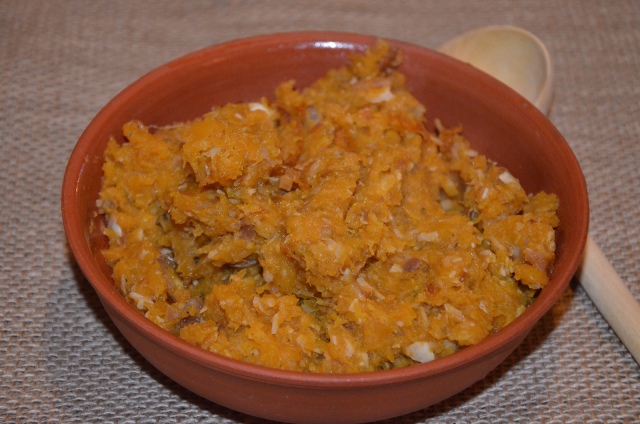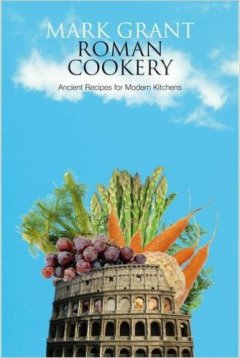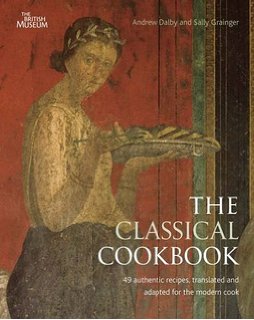I organised a small banquet at home on the occasion of the Saturnalia festival. I absolutely love ancient Roman food and for this banquet I tried a few more ancient recipes. Once again, everything was delicious!
For the appetizer (gustatio) I chose to bake Mustacei, must (grape juice) cakes from Cato The Elder’s De Agricultura. The recipe I used is taken from Mark Grant’s Roman Cookery as well as Sally Grainger’s The Classical Cookbook with some slight modifications. The recipe is slightly adapted using modern ingredients like yeast as the must of the Romans would have fermented. Sally Grainger believes that Cato’s cook experts would have expected the cakes to rise.
Mustacei recipe in Latin:
Cato’s De Agricultura 121: Mustaceos sic facito. Farinae siligineae modium unum musto conspargito. Anesum, cuminum, adipis P. II, casei libram, et de virga lauri deradito, eodem addito, et ubi definxeris, lauri folia subtus addito, cum coques.
Translation
Moisten 1 modius of wheat flour with must; add anise, cumin, 2 pounds of lard, 1 pound of cheese, and the bark of a laurel twig. When you have made them into cakes, put bay leaves under them, and bake.
Ingredients
- 400g plain flour
- 200ml red or white grape juice (I used red grape juice)
- 1/2 tsp dried yeast
- 60g cheddar or pecorino cheese, grated (I used pecorino)
- 2 tsp ground aniseed
- 2 tsp ground cumin
- 60g pastry lard (cooken) or hard vegetable fat (I used cooken)
- olive oil
- bay leaves
Method
Pour the grape juice into a pan and warm it to body temperature. Dissolve the yeast in the grape juice and leave to froth a few minutes. Grate the cheese. Put the flour into a missing bowl and stir in the ground cumin and aniseed. Add the grated cheese and lard/vegetable fat and work them into the flour until it has the consistency of bread crumbs. Pour on the grape juice and yeast mixture. Knead for 5 minutes until you have a supple dough and roll into a ball. Cover the bowl with a damp tea towel. Now brush a baking tray with olive oil and position the bay leaves on it at 5 cm intervals. Flour a board. Place the ball of dough on the board and use a rolling pin to roll out the dough until it is 1 cm thick. A pastry cutter about 5 cm in diameter can be used to make the individual cakes. Place each cake on a bay leaf and bake them at 180°C for 30-40 minutes.
Serve warm with a spoonful of date paste (Mark Grant recommends vegetable purée).
These sweet cakes should be accompanied with mulsum. Mulsum was a freshly made mixture of wine and honey with and a certain number of plants and spices (pepper, bay leaf, saffron) which was often served with the gustatio or before the meal as an aperitif. You can purchase mulsum online from the roman-shop site here.
Because I love chicken, for the main course (primae mensae) I chose to cook pullum (chicken) with Apicius’ hazelnuts sauce Aliter Ius in Avibus (Another Sauce for Fowl) from De Re Coquinaria. As Sally Grainger says, this recipe has a modern Christmassy feel. I decided to accompany this dish with Cucurbitas more Alexandrino (Alexandrine Squash), again from Apicius’ De Re Coquinaria.
Aliter Ius in Avibus recipe in Latin
Apicius 6,5,2: Piper, petroselinum, ligusticum, mentam siccam, cneci flos, uino suffundis, adicies ponticam uel amygdala tosta, mel modicum, uino et aceto, liquamen temperabis. Oleum in pultarium super ius mittis, calefacies, ius agitabis apio uiridi et nepeta. Incaraxas et perfundis.
Translation
Pepper, lovage, parsley, dry mint, fennel blossoms moistened with wine; add roasted nuts from Pontus or almonds, a little honey, wine, vinegar, and broth to taste. Put oil in a pot, and heat and stir the sauce, adding green celery seed, cat-mint; carve the fowl and cover with the sauce.
Ingredients
- 1 chicken or other bird
- 170g hazelnuts
- 4 tsp chopped fresh mint
- 2 tsp chopped fresh lovage or celery leaf
- 2 tsp chopped fresh parsley
- 2 tbsp clear honey
- 280ml red wine
- 2 tbsp red wine vinegar
- 2 tbsp fish sauce
- 1 tsp ground black pepper
- pinch saffron powder
- salt
Method
Roast the hazelnuts for 10 minutes in the oven at 180°C. Pound or process them to a fine crumb. Add them to a saucepan with all the other ingredients for the sauce and bring slowly to the boil. Place the chicken in a roasting pan and season with salt and pepper. Cut into the breast and leg and open the incisions before pouring the sauce over the bird. Roast in a pre-heated over at 200°C for about 1 1/2 hours. While cooking, repeatedly baste the bird to ensure that the skin is well covered in the nut mixture.
Conditum paradoxum, a delicate red wine with an exquisite blend of spices and honey (similar to today’s mulled wine) was served to accompany this dish. I have said it before but Conditum paradoxum is a true delicacy! You can purchase Conditum paradoxumonline from the roman-shop site here.
The Cucurbitas more Alexandrino (Alexandrine Squash) recipe comes from Apicius’ De Re Coquinaria.
Cucurbitas more Alexandrino recipe in Latin
Apicius 3,4,3: Elixatas cucurbitas exprimis, sale asparges, in patina compones. Teres piper, cuminum, coriandri semen, mentam viridem, laseris radicem, suffundes acetum. Addicies cariotam, nucleum, teres melle, aceto, liquamine, defrito et oleo temperabis, et cucurbitas perfundes. Cum ferbuerint, piper asparges et inferes.
Translation
Press the water out of the boiled pumpkin, place in a baking dish, sprinkle with salt, ground pepper, cumin, coriander seed, green mint and a little laser root; season with vinegar. Now add date wine and pignolia nuts ground with honey, vinegar and broth, measure out condensed wine and oil, pour this over the pumpkin and finish in this liquor and serve, sprinkle with pepper before serving.
Ingredients
- 1 gourd (small pumpkin or squash)
- peppercorns
- cumin
- coriander seeds
- 3 – 4 mint leaves, shredded
- 1 garlic
- 3 tbsp vinegar
- 50 g dates, finely chopped
- 50 g blanched almonds, finely chopped
- 2 tbsp clear honey
- 4 tbsp Defritum (or Wine or Grape Juice reduced by two thirds)
- 20 ml olive oil
- Sea salt to taste
Method
Cut the gourd, courgette or squash into chunks. Place these into a steamer and cook until done. Squeeze out the excess water. Transfer the remaining pulp to a saucepan. Whilst the squash is cooking, put the dried spices in a pestle and mortar and grind. Next add the mint and garlic, grinding to a smooth paste. Spoon this from the mortar and add to the cooked squash. Next add the dates, almonds and the honey. Finally add the oil and mix with the squash. Place the resulting mixture back on the heat and simmer gently for a few minutes for the flavours to combine. Serve immediately sprinkled with salt and black pepper.
The different species of gourd available today in Europe are the ones imported from the New Worlds. The squash used by the Romans would have been the bitter gourd native to North Africa. The bitter gourd differs substantially in shape and bitterness.
For the Secondae Mensae (dessert), I chose to try Apicius’ Dulcia Piperata, a peppered honey cake topped with chopped hazelnuts.
Dulcia Piperata recipe in Latin
Apicius 7,11,4: mittis mel, merum, passum, rutam. Eo mittis nucleos, nuces, alicam elixatam. Concisas nuces Avellanas tostas adicies et inferes.
Ingredients
- 140 gr plain flour
- 1 tsp baking powder
- 2 eggs
- ½ tsp ground rosemary
- 70 gr ground almonds
- 50 ml white grape juice
- 50 ml passum (or other 50ml white grape juice)
- 2 tbsp honey
- Milk
- Chopped hazelnuts
Method
Mix the flour in a bowl with the baking powder. Add the rosemary and the ground almonds to the bowl. In a measuring jug beat the two eggs, add the wine, grape juice, honey and mix well. Add enough milk to the jug to make the liquid up to 200 ml. Pour the liquid into the dry ingredients and mix well. Pour the mixture into a well greased 22cm round tin. Bake at 190ºC for about 30 minutes. When the cake is still warm, spread liquid honey over the top and sprinkle it with chopped hazelnuts.
If you are looking for some ancient eating inspiration why not give one of these recipes a go.
Bonum appetitionem!
Buy the cookbooks mentioned here:
